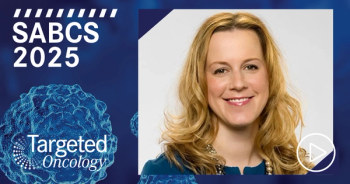
Long-Term Disease Control Exhibited With Axi-Cel in Large B-Cell Lymphoma
Patients with refractory large B-cell lymphoma experienced long-term disease control with rapid responses and robust CAR T-cell expansion with the CAR T-cell therapy axicabtagene ciloleucel.
Patients with refractory large B-cell lymphoma (LBCL) experienced long-term disease control with rapid responses and robust CAR T-cell expansion with the CAR T-cell therapy axicabtagene ciloleucel (axi-cel; Yescarta), according to data from the 4-year analysis of the phase 1/2 ZUMA-1 trial presented at the 2020 American Society of Hematology Annual Meeting.1
The median 4-year overall survival (OS) was 25.8 months (95% CI, 12.8-not estimable) in the modified intention-to-treat (mITT) population (patients treated with axi-cel; n = 101), who had a median follow-up of 51.1 months. This translated to a 4-year OS rate of 44% by Kaplan-Meier estimation.
Among the entire enrolled patient population (ITT; n = 111), the median OS was 17.4 months, and the Kaplan-Meier estimated 4-year OS rate was 41%.
“Altogether, these findings support the hypothesis that persistence of functional CAR T cells is not necessary for deep and durable remissions in LBCL,” said lead study author Caron Jacobson, MD, a senior physician and medical director of the Immune Effector Cell Therapy Program at Dana-Farber Cancer Institute. “Importantly, the brief time between enrollment and objective response observed for the ITT population supports the speed, success, and reliability of manufacturing.”
In October 2017, the FDA approved axi-cel, a CD19-directed CAR T-cell therapy, as a treatment for adult patients with relapsed/refractory non-Hodgkin lymphoma based on findings from the ZUMA-1 trial.
Results of the trial demonstrated an 82% objective response rate (ORR) and a complete response (CR) rate of 54%. After a median follow-up of 15.4 months, 42% of patients reported continued responses and 40% had continued CRs.2
The ZUMA-1 trial enrolled patients with refractory LBCL, including diffuse large B-cell lymphoma, primary mediastinal large B-cell lymphoma, and transformed follicular lymphoma. Patients had to have no response to their last chemotherapy or relapsed disease within 12 months of autologous stem cell transplant.
Following screening and leukapheresis, patients were given a conditioning chemotherapy regimen that consisted of 500 mg/m2 of cyclophosphamide and 30 mg/m2 of fludarabine for 3 days. Patients were hospitalized and given a single infusion of axi-cel at a dose of 2 x 106 CAR+ cells/kg. After a 7-day hospitalization period, the first tumor assessment occurred during follow up on day 28. The primary end point was ORR.
The updated data showed that evaluable patients who had available blood samples and were in ongoing response per institutional standard of care for at least 3 years (n = 21) had detectable B cells in blood at 3 years following CAR T-cell therapy infusion. Moreover, 67% of patients (n = 14) had detectable CAR gene-marked cells and polyclonal B cells in blood at 3 years.
Additionally, 91% of evaluable patients (n = 23) demonstrated polyclonal B-cell recovery. The median immunoglobulin kappa-lambda ratio was 1.6. The relative levels of key B-cell subsets, such as memory and naïve B-cell immunophenotypes, suggest reconstitution of the B-cell repertoire.
“Restoration of a polyclonal B-cell compartment and clearance of function CAR T cells [is] a key component of the long-term safety of CAR T-cell therapies,” said Jacobson, who is also an assistant professor of medicine at Harvard Medical School.
Regarding safety, no axi-cel–related secondary malignancies or cases of replication-competent retrovirus were reported at the 4-year cutoff date.
Furthermore, 59% (n = 66) of patients in the ITT population have died since study initiation. The primary causes of death include: progressive disease (n = 52; 47%), non-causal relationship events (n = 8; 7%), including myelodysplastic syndrome (n = 1) and cardiac arrest (n = 2), post-subsequent therapy events, including sepsis (n = 1), infection (n = 2), and pulmonary nocardiosis (n = 1), unknown event (n = 1), adverse effects (AEs; n = 5; 5%), including conditioning chemotherapy therapy–related tumor lysis syndrome (n = 1), non-causal relationship AEs (sepsis, n = 1; pulmonary embolism, n = 1), and axi-cel–related AEs (brain injury, n = 1; hemophagocytic lymphohistiocytosis/grade 5 cytokine release syndrome, n = 1), and secondary malignancy (n = 1; 1%).
Since the 2-year cutoff date, 8 patients died from progressive disease (n = 5) or secondary malignancy (n = 3). Notably, no new axi-cel–related serious AEs were reported, and 4 patients received intravenous immunoglobulin therapy.
References
1. Jacobson C, Locke FL, Ghobadi A, et al. Long-term survival and gradual recovery of B cells in patients with refractory large B cell lymphoma treated with axicabtagene ciloleucel. Presented at: 2020 ASH Annual Meeting; December 5-8, 2020; virtual. Abstract 1187.
2. Neelapu SS, Locke FL, Bartlett NL, et al. Axicabtagene ciloleucel CAR T-cell therapy in refractory large B-cell lymphoma. N Eng J Med. 2017;377(26):2531-2544. doi:10.1056/NEJMoa1707447








































